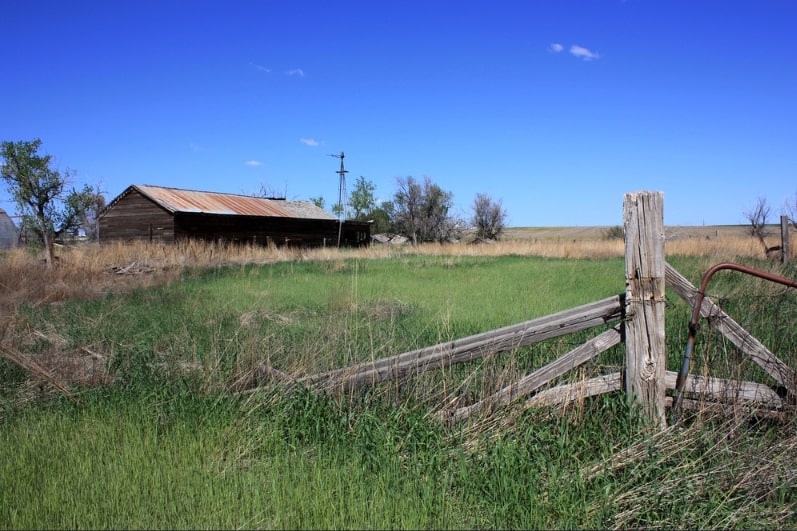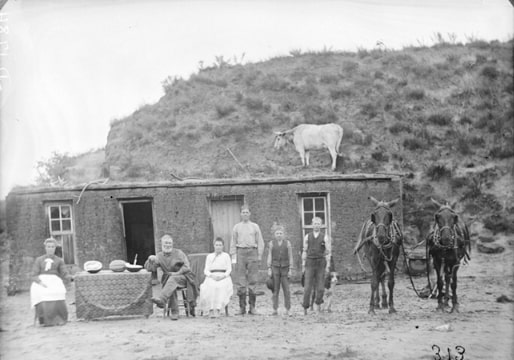Introduction: In this article – the second in a two-part series – Katie Rebecca Garner explores the records that homesteading left behind and where those records can be found. Katie specializes in U.S. research for family history, enjoys writing and researching, and is developing curricula for teaching children genealogy.
Homestead Records – Follow the Paper Trail
Both the complete and the incomplete (only about 40% of homesteaders completed the process) homesteads left paper trials, which can be used today to learn about homesteading ancestors. The final paperwork required for ownership of the homesteaded land was only filed for those who completed their homesteads. This included questionnaires about the land, use of the land, and settlement on the land by the homesteader’s family. Neighbors were witnesses and were asked how long they’d known the homesteader and whether they knew the homesteader resided on the land. It was common for people to witness each other’s homesteads. Because of this practice with witnesses, cluster or FAN club research can be helpful for homesteader ancestors. Even if your ancestors did not homestead, they may have witnessed for a neighbor.

Photo credit: https://depositphotos.com/home.html
Incomplete homesteads had no witness testimonies because they did not have the final application. The incomplete homesteads only have the papers that would have been filed at the beginning of the process, which are not usually housed with the complete files. This makes it more challenging to find these records.
All those who started the homesteading process filed an application. The surveyed land was recorded in tract books, indicating the first owner (homesteader or buyer) of each plot of land. Besides the application for the deed and witness testimonies of completed homesteads, records may also include newspaper announcements of the applicant proving their claim. If the ancestor was an immigrant or a military veteran, records of that information are included in the homestead files.
A lot of genealogically valuable information can be found in the homestead papers. This includes information about the homesteader’s family, his household, and his neighbors (the witnesses were usually neighbors). Witnesses had to state how long they knew the homesteader, where they lived relative to the homesteader, and list closer neighbors to the homesteader. Follow-up research can be done on the witnesses and other individuals they mention.
Tract Books Online
Each state keeps its own tract book and has its own organizational system. These can be found on FamilySearch. Christian Murri’s homestead entry (the man I was researching) was found in the tract book for the Utah land office. The tract book was organized by range and township, then by section. The FamilySearch tract book collection is not fully indexed, so it may need to be browsed. Christian Murri’s entry was found after browsing through the Utah books. It revealed that his homestead was for NW ¼ of section 22 in Township 3S Range 4E; that he applied on 30 October 1882 and was approved on 5 September 1888; and lists his entry number and final certificate number. (1) The tract books contain both the completed and incomplete homesteads. If your ancestor did not complete their homestead, finding it in the tract book may be the best way to discover it.
Other Online Homestead Records
Homestead records can be found at the Bureau of Land Management (BLM), the General Land Office (GLO), and the National Archives (NARA). The BLM only holds records for those who completed the process, and its website only has an index. Once the record has been identified, it can be ordered through the National Parks Service. NARA is in the process of digitizing its homestead records, and records from 10 of the 30 homesteading states have been fully digitized.
Christian Murri’s patent was issued from the Salt Lake City land office on 3 July 1890. This was found on the Utah land office and the GLO websites. (2) This is the document stating Christian Murri’s ownership of his homesteaded land.
Photo credit: https://depositphotos.com/home.html
Homestead Maps
The land office websites also include maps. The Utah Land Records BLM website includes an interactive map that allows users to zoom in on any range, township, or section. Christian Murri’s homestead site is located on this map. Another map found on the Utah BLM website shows the sections within Township 3S Range 4E and the property lines between the various land plots. A map found on the BLM GLO website shows the same sections with the terrain. (3)
Google Maps can also be used in homestead research. A landmark near Christian Murri’s homestead – Wasatch Mountain State Park – was searched on Google Maps, and his homestead property was located there. (4) The modern map could then be compared with the maps from the land offices.
Newspaper Research: Homesteading Announcements
Newspaper research can also help you find information about homesteading ancestors. Part of the homesteading process was placing announcements in the newspapers that the homesteader intended to prove their claim. These announcements can be found in GenealogyBank’s Historical Newspaper Archives.
One of the homestead papers includes a form stating which newspaper the announcement was run in, how many times it was run, and the start and end dates of the announcement. The files may also include a signed statement by the newspaper’s manager. Additionally, there may be newspaper announcements of abandoned homesteads.
How do you know if your ancestor homesteaded? Other records can give clues. One place to check is the census. Note the birthplaces of the family members for migration clues. A possible homestead would be indicated by a westward migration after 1862. Also, pay attention to the occupation of the head of household. A homesteader would be a farmer owning property. Check the agricultural schedules to see how much land your ancestors owned. If it was 160 acres (or 320 or 640 acres in the 20th century), it’s likely homestead land.
Other clues include deed books showing the United States as the grantor, tax lists, and probate records describing the land holdings. You may also find clues in county histories and historical monographs.
Do you have ancestors who homesteaded? Start searching these collections for their records, including GenealogyBank’s Historical Newspaper Archives.
Explore over 330 years of newspapers and historical records in GenealogyBank. Discover your family story! Start a 7-Day Free Trial
Note on the header image: Sylvester Rawding family sod house, 1886. Credit: Solomon D. Butcher; Wikimedia Commons.
Related Article:
Resources:
- https://familytreewebinars.com/webinar/the-homestead-act-of-1862/?category=records&subcategory=homestead1862
- https://familytreewebinars.com/webinar/homestead-act-of-1862-following-the-witnesses/?category=records&subcategory=homestead1862
- https://familytreewebinars.com/webinar/women-homesteaders-and-genealogy-bonus-webinar-for-subscribers/?category=records&subcategory=homestead1862
- https://www.familysearch.org/rootstech/session/ladies-and-land
- https://www.familysearch.org/rootstech/session/immigration-and-the-homestead-act-finding-your-ancestors
- https://www.familysearch.org/rootstech/session/go-west-american-migration-1783-to-1900
- https://www.familysearch.org/rootstech/session/ethnic-and-religious-community-formation-under-the-homestead-act
- https://www.familysearch.org/rootstech/session/the-roots-beneath-your-feet-stories-from-homesteading-descendants
- https://www.familysearch.org/rootstech/session/3-the-lay-of-the-land-using-american-land-records-in-your-family-history-research
_____________________________
(1) Bureau of Land Management, Records Improvement [U.S. Tract Books], digital image, FamilySearch (https://familysearch.org: accessed 19 July 2023), Utah, Volume 30, p. 152, homestead entry for Christian Murri, 30 October 1882, NW ¼ of Section 22, Township 3S, Range 4E, certificate of purchase #5787, FHL Film #007115140, image #667.
(2) Bureau of Land Management, “Land Patent Search,” digital images, General Land Office Records (https://glorecords.blm.gov: accessed 19 July 2023), Christian Murri (Wasatch County, Utah), homestead patent no. 3927; Bureau of Land Management, “Search CDI by Document ID,” digital images, “Utah Land”
(3) Bureau of Land Management, “Land Patent Search,” digital images, General Land Office Records (https://glorecords.blm.gov: accessed 25 July 2023), Plat Image, DM ID 345634, original survey, Utah.
(4) Google Maps. (2023) Wasatch Mountain State Park. https://goo.gl/maps/9UWoggxvh8RMd53r8: accessed 25 July 2023.
